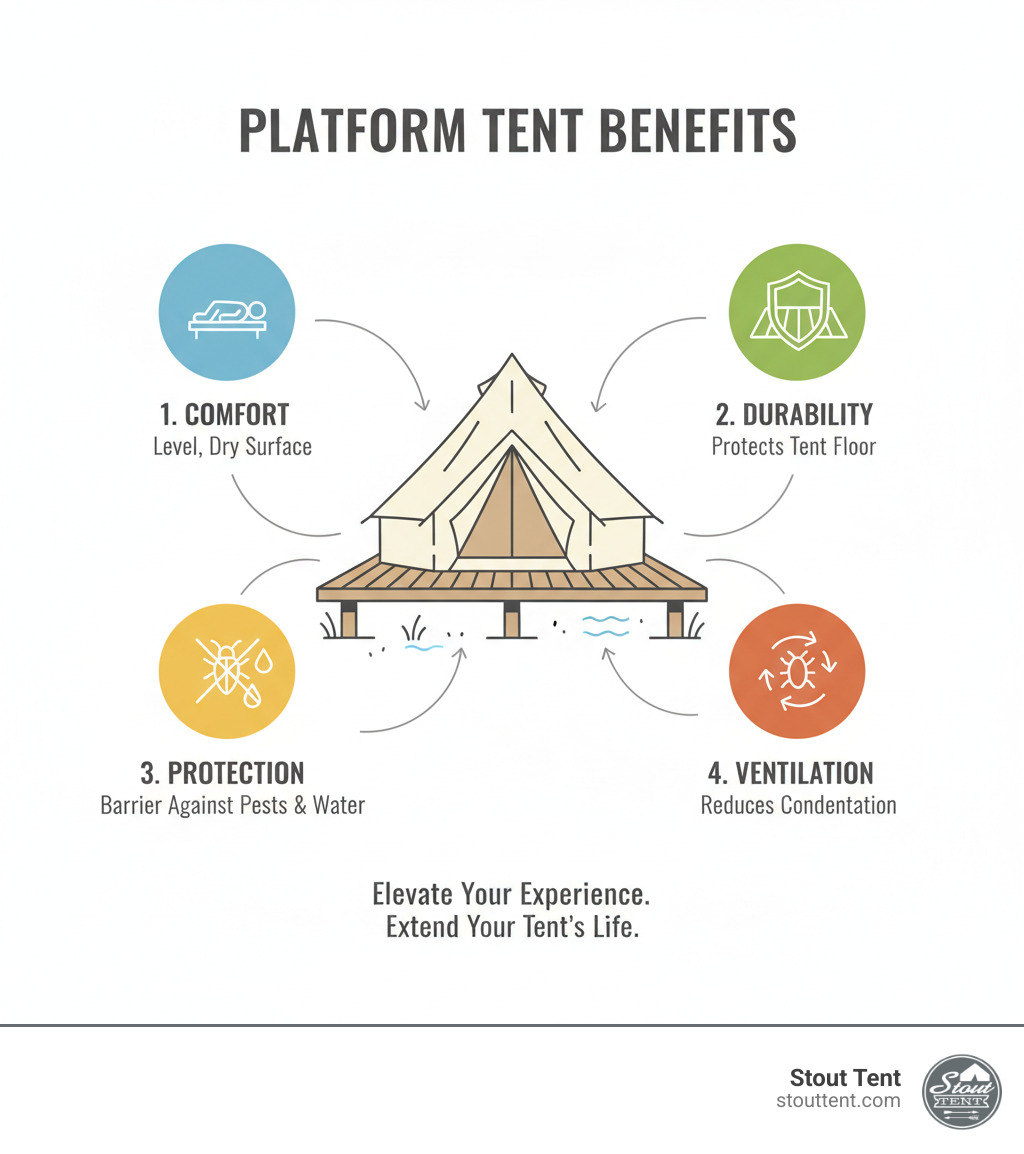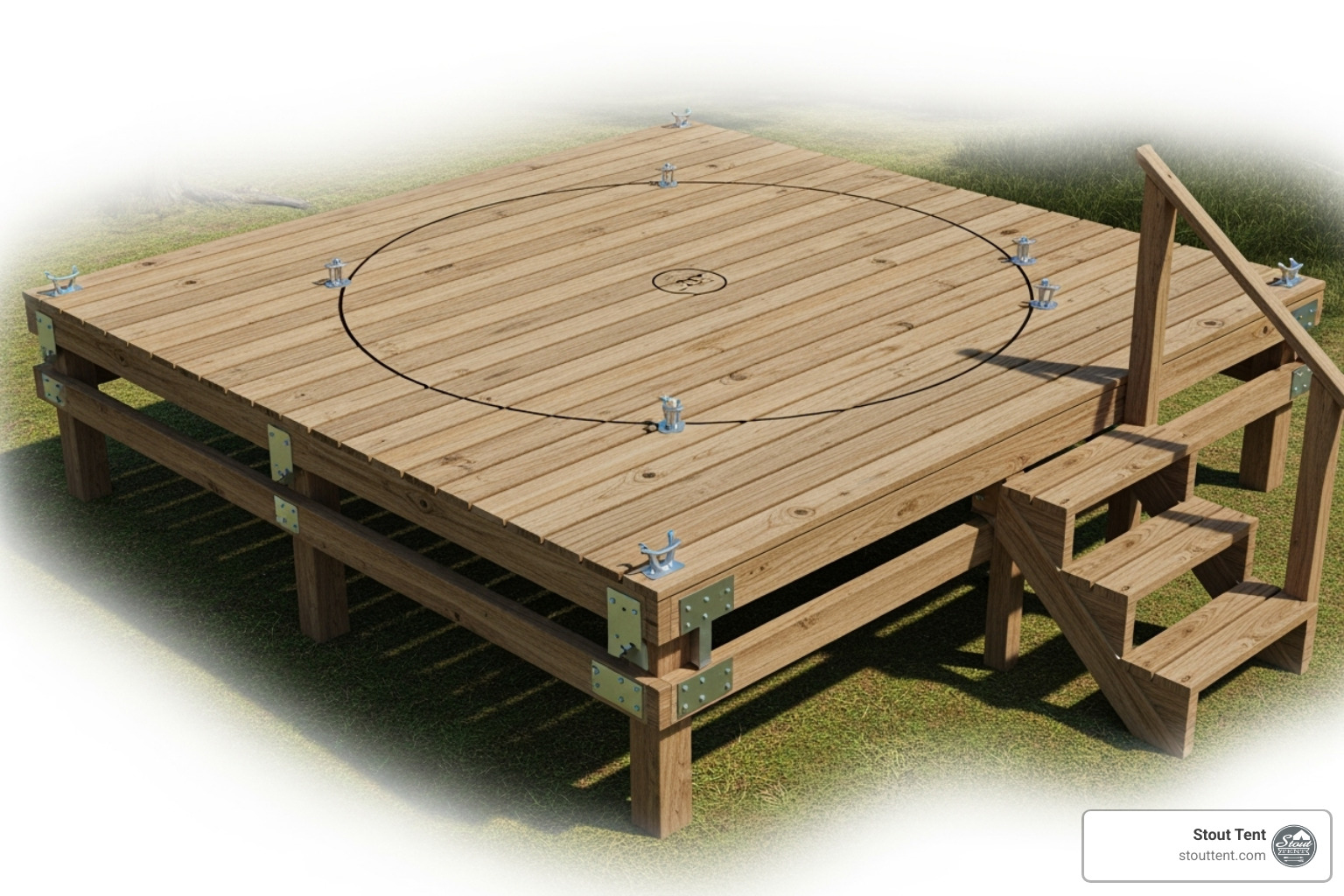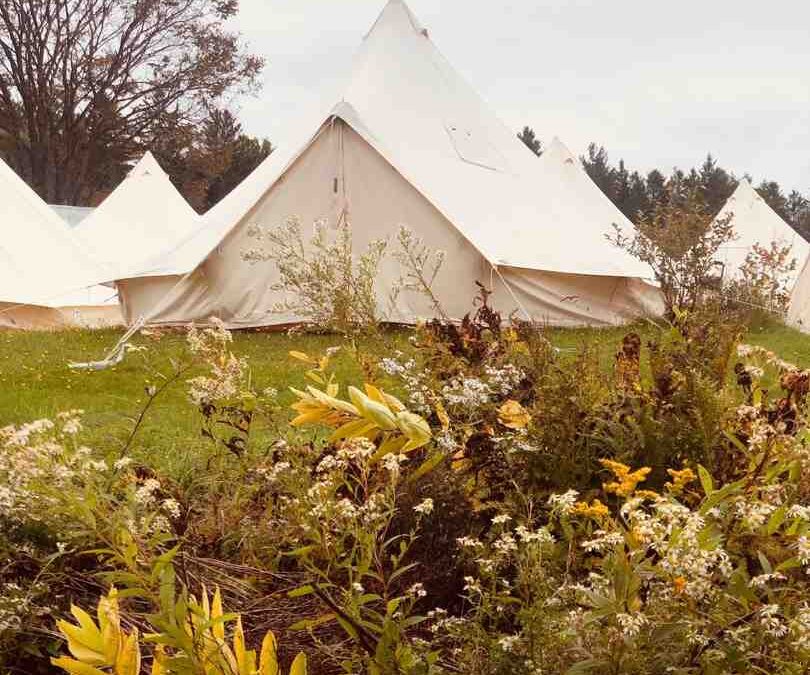Why a Raised Platform Transforms Your Canvas Bell Tent Experience
A raised platform gives your canvas tent a foundation worthy of its craftsmanship. At Stout Tent, we don’t sell “platform tents”—we build canvas tents that perform beautifully on platforms. The platform is an optional foundation you can build to improve your tent’s comfort, drainage, and longevity. You’re not buying a different kind of tent—you’re building a better home for the one you already love.
Quick Answer: What are the primary benefits of setting up your canvas bell tent on a raised platform?
- Improved Comfort – A level, solid surface eliminates cold and moisture from the ground.
- Increased Durability – Protects your tent floor from rocks, roots, and constant ground contact.
- Superior Protection – Creates a barrier against insects, pests, and rainwater runoff.
- Better Ventilation – Airflow underneath prevents condensation and keeps your tent dry.
- Improved Aesthetics – Transforms your tent into a polished, structured outdoor living space.
This guide is for glamping entrepreneurs, event producers, and long-term campers seeking to create a durable and refined outdoor living space. A properly constructed platform setup is one of the smartest investments you can make, creating a stable, lifted foundation that extends your tent’s lifespan while delivering superior comfort.
For enterprise clients managing multi-year event calendars, this approach significantly reduces Total Cost of Ownership (TCO). A well-built platform protects your canvas investment from ground wear, extending replacement cycles and reducing long-term asset depreciation.
I’m Caitlyn Stout, founder of Stout Tent, and over the past decade I’ve helped hundreds of clients worldwide design and deploy canvas bell tent installations on raised platforms for everything from luxury glamping resorts to scout camps. My hands-on experience with international deployments across six continents has taught me what works—and what fails—when building a foundation for canvas tents in diverse environments.

Why Build a Platform for Your Canvas Bell Tent?
Investing in a raised canvas tent installation is a strategic decision that transforms how your canvas bell tent performs. From the misty mornings in the Pacific Northwest to the arid expanses of the Black Rock Desert, a well-designed platform completely changes the camping experience.

Improved comfort is the most immediate benefit. A platform provides a perfectly level, dry surface, free from the chill and dampness of the ground. This consistent foundation eliminates cold spots and moisture, ensuring guests sleep warmer and more comfortably, as if in a real bed.
Increased tent longevity makes a compelling business case for glamping retreats or long-term installations. Lifting your canvas bell tent protects its floor from rocks, roots, and ground moisture, extending its useful life by years. Our data from commercial use across six continents shows that tents on platforms experience dramatically less floor wear. For enterprise clients, this lowers the Total Cost of Ownership (TCO) by reducing replacement cycles and protecting your capital investment.
Superior protection is built into every raised canvas tent installation. The elevation creates a formidable barrier against insects, rodents, and rainwater runoff. Our experience deploying tents in the Southwest, where flash floods are a risk, has proven the value of this elevation. The platform channels water away, keeping the interior dry even during heavy downpours.
Improved aesthetics and functionality transform a tent into a structured outdoor living space. A platform provides a stable base for furniture, creating a polished, intentional retreat. For glamping sites, this lifts the guest experience, making the tent feel less like temporary shelter and more like a carefully designed home.
Better ventilation is a crucial, though less obvious, benefit. Airflow underneath the platform prevents condensation by allowing moisture to escape. This continuous circulation keeps the tent floor dry, prevents mildew, and maintains a fresher interior, which is critical in humid climates or areas with large day-night temperature swings.
Designing the Perfect Tent Platform Setup
Building a platform for your canvas bell tent is about creating a lasting foundation. Over the past decade, I’ve seen hundreds of these structures built across every imaginable terrain, from the rain-soaked forests of the Pacific Northwest to the dusty expanses of Nevada’s Black Rock Desert. A successful, long-lasting platform always begins with thoughtful design.

Image: A detailed blueprint or 3D model of a tent platform, showing joists and footings.
Site selection is paramount. A level spot is ideal, but understanding the land’s natural drainage, wind patterns, and sun exposure is even more critical. Working with the landscape, not against it, prevents future problems.
The platform should match your canvas bell tent’s footprint, with a small perimeter for anchoring guy lines and maintenance. Many of our glamping clients extend one side to create a covered porch, a simple addition that transforms the guest experience by providing a dedicated outdoor living space.
Structural design requires precision. For a standard 16′ x 20′ raised canvas tent installation, we recommend a frame of 4″ x 4″ posts and 2″ x 6″ joists spaced appropriately to provide robust support. In areas with heavy snow loads, the design must be properly engineered to handle the additional weight, ensuring the platform remains stable and level through all seasons.
Pressure-treated lumber is the standard for its resistance to rot, insects, and moisture. For decking, both pressure-treated and composite materials perform well, with the choice depending on your budget and maintenance preferences. Material selection should always reflect the specific environmental challenges of your site.
The beauty of a well-designed platform is its adaptability to any location while providing a stable, level surface for your canvas bell tent. For detailed specifications and construction guidance, our comprehensive Deck and Platform Guide provides plans refined from real-world feedback across six continents. A properly designed platform will serve you for a decade or more.
Key Construction Principles for a Durable Platform
Building a platform is a rewarding project that lifts your outdoor space. This section provides guidance on key principles, not a complete building plan. For detailed instructions, we highly recommend consulting a professional or our comprehensive DIY Tent Platform Complete Guide.
Foundation and Framing for Stability
The platform’s foundation is where lasting success is built. Use pressure-treated lumber for posts set on gravel footings to ensure proper drainage and prevent rot. The structural skeleton, composed of joists and beams, must be robust. For a typical 16′ x 20′ raised canvas tent installation, we recommend spacing interior joists at 13.3 inches on center and using joist hangers to maximize strength. A perfectly level frame is non-negotiable; it affects everything from sleep quality to water drainage. In regions with heavy snowfall, the frame must be engineered with additional rafters to support the load—a critical safety measure. Adhering to Leave No Trace principles during construction ensures you build responsibly.
Decking and Drainage Solutions
Once the frame is complete, the decking provides the living surface. A 1/2-inch gap between deck boards is essential for allowing rainwater to drain through, preventing pooling. The tent’s sod cloth can be secured on top of the platform or draped over the edge and fastened for a tighter seal against insects and driving rain.
Anchoring Your Canvas Tent Securely
Proper anchoring makes the installation weather-resistant. Secure the tent’s groundsheet directly to the deck using screws and washers through the integrated grommets. Guy lines should align with the tent’s seams and be anchored to dedicated posts or points off the platform, maintaining the tent’s structural tension. These details transform your canvas bell tent into a stable, secure outdoor home.
Choosing the Right Canvas Tent for Your Platform
A well-constructed platform deserves a canvas bell tent that matches its durability and aesthetic. At Stout Tent, we specialize in professional-grade canvas bell tents perfectly suited for permanent or semi-permanent raised canvas tent installations.
Canvas Bell Tents: The Ideal Choice
Our canvas bell tents are renowned for their robust construction and classic aesthetic, making them an ideal choice for any canvas tent platform setup. The single center pole and radial design distribute tension evenly, creating a stable structure that performs beautifully when anchored to a solid deck. They are designed to withstand long-term use in diverse weather, from the intense sun of Phoenix to the brisk air of the Pacific Northwest. Explore our full range of Stout Bell Tents to find the perfect fit.
Sizing and Key Features
Your platform should be at least the size of your tent’s footprint. For platform setups, certain features are critical. Our tents feature heavy-duty, waterproof floors, which are essential for a sealed, comfortable interior when lifted. For a true 4-season tent experience, stove jack compatibility allows for safe heating, extending your operating season. Finally, robust guy line attachment points are essential for securing the tent against high winds.
Quality Materials and TCO
Our canvas bell tents are crafted from expert-tested, professional-grade materials. We use durable, breathable canvas treated for water and mildew resistance to ensure long-lasting performance. Crucially, our tent frames are constructed from solid brass. This provides superior strength and corrosion resistance that steel cannot match, as brass doesn’t rust or weaken over time. This commitment to quality means a lower Total Cost of Ownership (TCO) for our enterprise clients. A Stout Tent is a long-term asset that reduces replacement costs and delivers reliable performance, event after event.
Frequently Asked Questions about Canvas Tent Platform Setups
What materials are best for a durable tent platform?
Pressure-treated wood is the most popular choice, offering excellent, cost-effective resistance to rot, insects, and moisture. We’ve seen these platforms perform beautifully from the humid Pacific Northwest to the dry heat of Arizona. For a lower-maintenance solution, composite decking is a smart investment for commercial glamping operations, though it has a higher upfront cost. The best material depends on your budget, climate, and expected lifespan.
How does a raised canvas tent installation handle bad weather?
A properly built canvas tent platform setup excels in bad weather. The elevation provides superior drainage during heavy rain, preventing water from pooling under your tent. When anchored correctly to the stable base, the tent gains improved wind resistance, keeping it taut and secure. For regions with heavy snowfall, the platform frame must be engineered with additional rafters (e.g., every 2 feet) to support the weight. This reinforcement is non-negotiable for safety in winter installations and transforms your tent into a reliable four-season shelter.
What are the cost and effort implications of building a platform for a tent?
Building a platform requires an upfront investment of time and money, with costs varying by size and materials. However, this investment pays dividends by dramatically increasing your tent’s comfort and longevity. For our enterprise clients, this translates directly into a lower Total Cost of Ownership (TCO) over multi-year event calendars. A tent floor that might wear out in two seasons on the ground can last five or more when protected by a platform. You’re not just building a deck; you’re extending the life of a professional-grade asset, ensuring it performs reliably for any long-term setup.
Conclusion: Build Your Foundation for a Better Glamping Experience
Building a platform transforms your canvas bell tent from a temporary shelter into something more permanent and meaningful. It’s the foundation that protects your investment, lifts your comfort, and creates the kind of outdoor space people remember long after they leave.
Over the past decade, I’ve watched hundreds of clients across the country—from Phoenix to the Pacific Northwest, from the Black Rock Desert to the Northeast—build these foundations and see their vision come to life. A properly constructed canvas tent platform setup isn’t just about keeping the floor dry. It’s about creating an outdoor accommodation that delivers consistent quality, season after season, event after event.
For enterprise clients managing recurring events, this foundation directly impacts your bottom line. A well-built platform protects your canvas investment from ground wear, extending its functional lifespan and reducing replacement costs over multi-year event calendars. That’s not marketing talk—it’s operational reality. When your infrastructure holds up under pressure, your Total Cost of Ownership drops significantly.
Whether you’re launching your first glamping retreat or scaling an established operation, the platform is where it all begins. It’s the foundation that makes everything else possible.
Ready to create the ultimate outdoor accommodation?
- Explore our collection of Canvas Bell Tents, designed for beautiful platform installations that last for decades.
- For platform specifications and layout guidance, contact our team or view our comprehensive Deck and Platform Guide.

